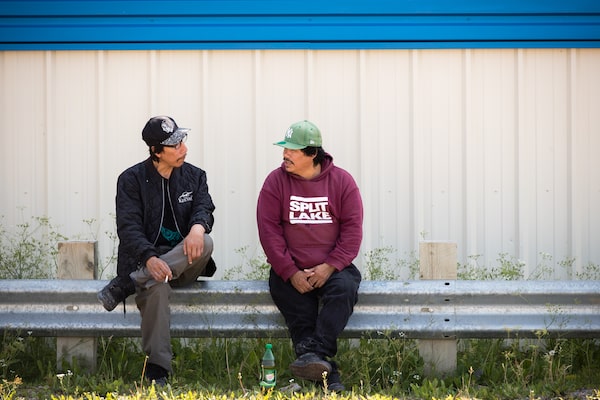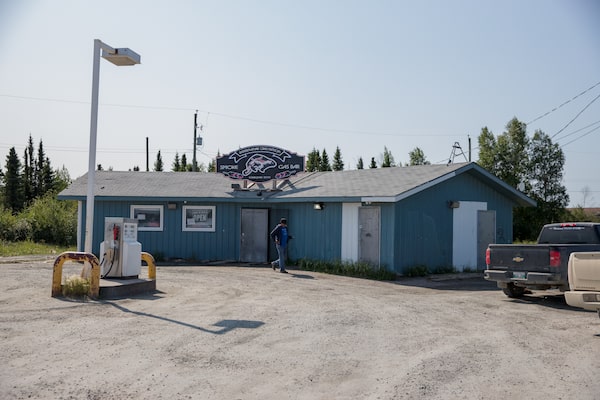A sign marks the end of Manitoba Provincial Road 290, about 50 kilometres outside Gillam, Man., and 26 km from where fugitives Kam McLeod and Bryer Schmegelsky abandoned and burned their vehicle. An RCMP-led manhunt for the two homicide suspects is ongoing.Photography by Melissa Tait/The Globe and Mail
Since Kam McLeod and Bryer Schmegelsky left Port Alberni two and a half weeks ago, they’ve travelled at least 6,000 kilometres through the mountains and forests of Northern British Columbia – where they are suspected of killing three people – and then on the run through Alberta and Saskatchewan to the wilderness of northeastern Manitoba. There, their trail has run cold.
To catch the suspects, the RCMP have marshalled intensive resources across four provinces and beyond, bringing in teams of officers and using helicopters, drones, door-to door-canvassing, checkstops and assistance from the military to search the difficult northern terrain. But the teens still have not been found.
“It’s not abnormal for us to have cases that go on for an extended period due to suspects being on the lam. In some cases, it does take a lucky break and assistance from the public,” said Inspector Kevin Lewis, incident commander for the RCMP. “We do have other investigative means under way and it’s just a matter of time before luck is in our favour.”
Mr. McLeod, 19, and Mr. Schmegelsky, 18, are charged with second-degree murder in the death of University of British Columbia botany lecturer Leonard Dyck, 64, whose body was found near Dease Lake, B.C., and have been identified as suspects in the homicides of American Chynna Deese, 24, and Australian Lucas Fowler, 23, who were found dead near the Liard Hot Springs.
Initially considered only missing – and even potential victims – after their burned-out vehicle was found near Mr. Dyck’s body on July 19, Mr. McLeod and Mr. Schmegelsky had a head start of four days before being publicly declared suspects by the RCMP on July 23.
Kam McLeod and Bryer Schmegelsky are still at large. Here is some surveillance footage of them from a store in Meadow Lake, Sask., released by Manitoba RCMP.

1
CANADA
2
3
4
5
B.C.
ALTA.
SASK.
MAN.
0
300
U.S.
KM
280
6
Stephens Lake
7
Gillam
MANITOBA
Split Lake
0
12
8
KM
July 15, near Liard Hot Springs:
Two bodies found on Alaska Highway
1
July 18, Jade City:
Suspects spotted
2
July 19, Dease Lake:
A body found two kilometres
from truck belonging to suspects
3
July 21, Cold Lake:
Suspects spotted
4
July 21, Meadow Lake:
Suspects spotted
5
July 22, Split Lake:
Band constables pulled the pair over
before they were named suspects
6
July 22, Fox Lake Cree Nation:
Suspects’ burned-out vehicle found
7
July 28, York Landing:
Unconfirmed sighting of the suspects
8
THE GLOBE AND MAIL, SOURCE: TILEZEN;
OPENSTREETMAP CONTRIBUTORS; HIU

1
CANADA
2
3
MAN.
4
5
B.C.
ALTA.
SASK.
0
300
U.S.
KM
280
6
Stephens Lake
7
Gillam
MANITOBA
Split Lake
0
12
8
KM
July 15, near Liard Hot Springs:
Two bodies found on Alaska Highway
1
July 18, Jade City:
Suspects spotted
2
July 19, Dease Lake:
A body found two kilometres from
truck belonging to suspects
3
July 21, Cold Lake:
Suspects spotted
4
July 21, Meadow Lake:
Suspects spotted
5
July 22, Split Lake:
Band constables pulled the pair over
before they were named suspects
6
July 22, Fox Lake Cree Nation:
Suspects’ burned-out vehicle found
7
July 28, York Landing:
Unconfirmed sighting of the suspects
8
THE GLOBE AND MAIL, SOURCE: TILEZEN; OPENSTREETMAP
CONTRIBUTORS; HIU

0
300
July 18, Jade City:
Suspects spotted
July 15, near Liard Hot Springs:
Two bodies found on Alaska Highway
KM
July 21,
Cold Lake:
Suspects spotted
CANADA
ALBERTA
SASK.
BRITISH
COLUMBIA
MANITOBA
July 19, Dease Lake:
A body found two
kilometres from truck
belonging to suspects
July 21,
Meadow Lake:
Suspects spotted
U.S.
0
12
KM
July 22, Split Lake:
Band constables pulled the pair over before they were named suspects
280
Stephens Lake
Gillam
MANITOBA
July 22, Fox Lake
Cree Nation:
Suspects’ burned-
out vehicle found
July 28, York Landing:
Unconfirmed sighting
of the suspects
Split Lake
THE GLOBE AND MAIL, SOURCE: TILEZEN; OPENSTREETMAP CONTRIBUTORS; HIU
There has not been a confirmed sign of Mr. McLeod and Mr. Schmegelsky since the evening of July 22, when the grey Toyota RAV4 they were driving was found burning in a ditch near Fox Lake Cree Nation in Manitoba. The last confirmed physical sighting of the two men was earlier that day some 170 kilometres southwest, when they stopped to get gas in the community of Split Lake, also known as the Tataskweyak Cree Nation.
Though there have been reported sightings since – including a report Sunday that the men had been seen rooting for food at the garbage dump in York Landing, a two-hour ferry ride away from Split Lake – they have not been located. The RCMP said on Tuesday that investigators have not been able to substantiate the York Landing sighting and have since pulled out of the area.
The RCMP say searches are continuing at “high probability areas” around Gillam, 58 kilometres away from Fox Lake Cree Nation and where much of the search has been focused.
Speaking to The Globe on Tuesday from her home in Charlotte, N.C., Ms. Deese’s mother, Sheila Deese, said she was sickened by the continuing search.
“I want them caught. I want them to have consequences,” she said. “That’s what so much of everything is about. The story is about Chynna and Lucas, but so much of the focus is these boys, these evil, evil boys.”
Chynna Deese, right, with mother Sheila in a family handout photo.
The RCMP say none of the more than 260 tips in the past week has established with any certainty that the suspects are still in the Gillam area. In the surrounding communities and beyond, people are wondering how the teens are surviving in the rugged terrain, whether they’re receiving help and if, at this point, they’re even still alive. “I bet they are going south and following the power line trails,” speculated Howard Spence, 49, sitting outside the grocery store in Split Lake on Tuesday.
Mr. Spence and Eddie Kitchekeesik, 51, say they think the fugitives may have retreated into the bush and are hiding in a trapper’s cabin or in one occasionally used by hydro workers. While the soft mossy ground of the northern woods makes much of the terrain difficult to traverse by foot, there are firmer pathways along power lines, rail routes and rivers. “I bet they are running for their lives,” Mr. Kitchekeesik said. “I hope they are losing strength and will be caught.”

Eddie Kitchekeesik and Howard Spence sit in their regular spot outside the Northern store in Split Lake, Tataskweyak Cree Nation.
In Cold Lake, Alta., Tommy Ste-Croix said he encountered the suspects stuck in a grey SUV on a muddy road near his brother’s house on July 21 and unwittingly helped them on their way.
“I assumed they were young teens with mom and dad’s SUV,” Mr. Ste-Croix said in an e-mail. As he helped free the vehicle, Mr. Ste-Croix said he ribbed them about getting their parents’ vehicle covered in mud. He said Mr. McLeod replied: “Oh don’t worry, they told me to go for a long joy ride.”
He said the two seemed good-natured – albeit “a little nerdy” – but said they appeared nervous, which he attributed to their stuck SUV. He says when he saw the suspects on the news his “jaw dropped,” and he called the RCMP.
“I truly hope they turn themselves in and face the consequences as soon as possible before they, or anyone else, gets hurt,” he said.
This is the ditch near Gillam the suspects are believed to have burned out their car before possibly escaping into the bush.

The last confirmed sighting of the men was on July 22 at the Tataskweyak Cree Nation gas bar, shown here on July 30.
While manhunts of this kind are uncommon in Canada, they are certainly not unprecedented. Other intense and large-scale searches have stretched on for weeks and longer before ending in capture, surrender or death.
Glenn Woods, a criminal profiler and former director of the RCMP’s behavioural-sciences branch, was involved in a number of searches throughout his 35-year career, including the hunt for New Brunswick’s Allan Legere, the so-called Monster of Miramichi. Mr. Legere was on the run for seven months after he escaped custody in 1989, and killed four more people before he was rearrested near Miramichi after a botched carjacking.
“I think the public suffers from a ‘CSI complex’ – the idea that there’s technology out there for everything,” said Mr. Woods, founder of consulting company Behavioural Analysis Investigation & Training (BAIT) Group. “While there have been many advances in technology, sometimes you just can’t find people until you do the background, especially in the territory and environment they’re in now.”
Mr. Woods said police face a number of serious challenges in these situations, including mitigating the potential for further violence and wading through a flood of incoming tips, taking care not to widen the search area too broadly, while considering whether the suspects are still in the area where they were last seen. “You do what you can. You follow the leads,” he said. “Some of the best investigative minds in the country are on this. It’s a big country. They’re in an area that’s difficult not only for the suspects, but also for the police.”
In Gillam, Mayor Dwayne Foreman said some residents don’t believe Mr. McLeod and Mr. Schmegelsky will be located in the area, but things will not return to normal until they are found, one way or another. “There has to be some resolution of some sort so everyone can have peace of mind,” he said.
With reports from Andrea Woo, Justin Ling and Ian Bailey
Canadian manhunt: In-depth coverage from The Globe and Mail
Searching for answers: Sense of unease lingers in B.C.’s isolated north as police hunt suspects
Winnipeg’s Bear Clan Patrol moves from city to wilderness in response to manhunt
Past manhunts in Canada: A historical primer
Our Morning Update and Evening Update newsletters are written by Globe editors, giving you a concise summary of the day’s most important headlines. Sign up today.